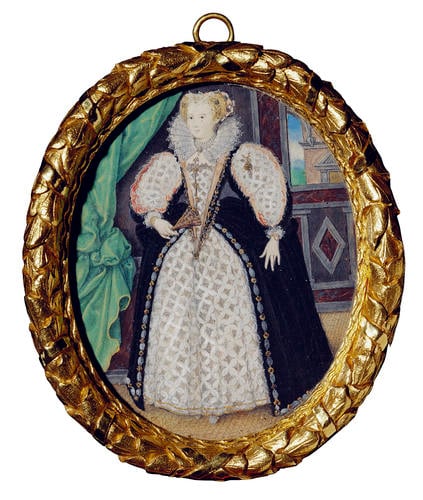-
1 of 253523 objects
Portrait of a Lady, perhaps Penelope, Lady Rich (1563-1607) c.1589
Watercolour on vellum laid on card | 5.7 x 4.6 cm (support, canvas/panel/stretcher external) | RCIN 420020
-
Nicholas Hilliard, the son of an Exeter goldsmith, was apprenticed to Elizabeth I's goldsmith and jeweller, Robert Brandon, whose daughter he married in 1576. He began to paint miniatures in 1560, later claiming that he was in general terms influenced by Hans Holbein the Younger and Albrecht Dürer. Although he worked for the English court, Hilliard travelled to France (1576-9) in search of additional patronage and would have encountered the work of François Clouet during that visit. Regardless of these particular formative influences and of others cited in his Treatise concerning the Arte of Limning (c.1600), Hilliard's style - based on sophisticated technical knowledge - is distinctive; it incorporates a glorious sense of design most evident in the treatment of costume with all its accessories, and the calligraphic flourishes of his inscriptions. Most closely associated with the court of Elizabeth I, Hilliard's appointment as Court Limner was renewed during the reign of James I, although it is often argued that by that time his style had become old fashioned. There are eighteen autograph miniatures by Hilliard in the Royal Collection, including five portraits of Elizabeth I and three of James I.
Hilliard's introduction of a full-length figure within the small oval format was an important development in the history of the miniature. Here the figure is shown in a first-floor interior framed on the left by a curtain with a view of another wing of the building beyond on the right. The liveliness of the portrait stems as much from the pose, particularly of the arms and the hands with long fingers, as from the placing of the figure within the composition.
Lady Rich was born Penelope Devereux (?1563-1607), the sister of Elizabeth I's favourite, Robert Devereux, second Earl of Essex. She married Robert, Lord Rich, later Earl of Warwick, in 1581, but they were legally separated in 1605. Several years before that, her great beauty - sparkling dark eyes and fair hair ('waves of gold') - had been a source of inspiration for Sir Philip Sidney's Stella in his poem Astrophil and Stella (1591). Hilliard named one of his daughters after Lady Rich.
The identification of the sitter has however been the subject of some discussion. It is known that Hilliard painted two miniatures of Lady Rich, in 1589 and 1590 respectively, the earlier of which was the subject of a sonnet by Henry Constable. This first miniature was given to James VI of Scotland (later James I of England) and the second to the French ambassador. It is possible that the present miniature may be linked with one of these. The most potent argument in favour of the identification of the sitter as Lady Rich is that, in an age when jewellery very often carried a symbolic meaning, this subject wears in her hair a five-pointed star- ('stella') shaped jewel.
Catalogue entry adapted from Royal Treasures, A Golden Jubilee Celebration, London 2002Provenance
Lord de Roos; probably his sale Christie's, London 4 June 1839 (102); Queen Victoria by 1870
-
Creator(s)
-
Medium and techniques
Watercolour on vellum laid on card
Measurements
5.7 x 4.6 cm (support, canvas/panel/stretcher external)
6.4 x 6.0 cm (frame, external)
Other number(s)
Alternative title(s)
Anne Clifford, Countess of Pembroke and Dorset (b. 1590), previously identified as
